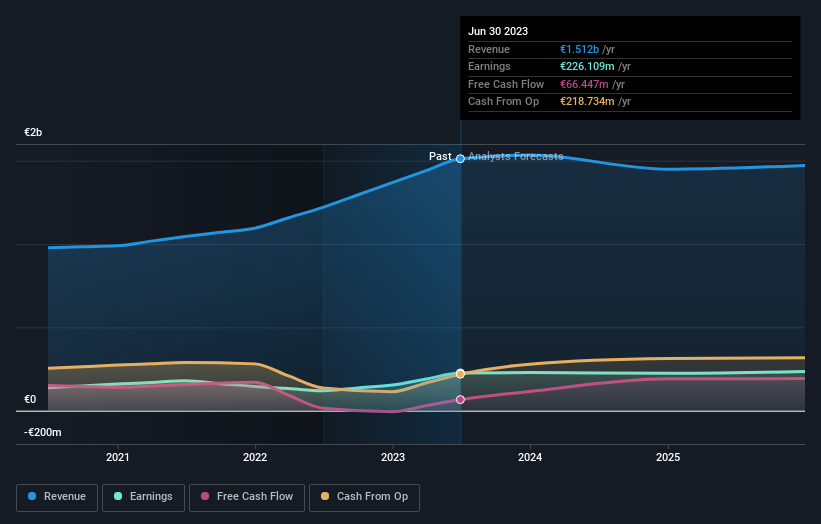Stock Analysis
Retail investors in Vidrala, S.A. (BME:VID) are its biggest bettors, and their bets paid off as stock gained 4.4% last week

Key Insights
- Significant control over Vidrala by retail investors implies that the general public has more power to influence management and governance-related decisions
- 49% of the business is held by the top 25 shareholders
- Institutions own 18% of Vidrala
Every investor in Vidrala, S.A. (BME:VID) should be aware of the most powerful shareholder groups. The group holding the most number of shares in the company, around 46% to be precise, is retail investors. Put another way, the group faces the maximum upside potential (or downside risk).
As a result, retail investors collectively scored the highest last week as the company hit €2.4b market cap following a 4.4% gain in the stock.
Let's take a closer look to see what the different types of shareholders can tell us about Vidrala.
See our latest analysis for Vidrala

What Does The Institutional Ownership Tell Us About Vidrala?
Institutions typically measure themselves against a benchmark when reporting to their own investors, so they often become more enthusiastic about a stock once it's included in a major index. We would expect most companies to have some institutions on the register, especially if they are growing.
Vidrala already has institutions on the share registry. Indeed, they own a respectable stake in the company. This implies the analysts working for those institutions have looked at the stock and they like it. But just like anyone else, they could be wrong. If multiple institutions change their view on a stock at the same time, you could see the share price drop fast. It's therefore worth looking at Vidrala's earnings history below. Of course, the future is what really matters.

Vidrala is not owned by hedge funds. Mugarburu, S.L. is currently the company's largest shareholder with 7.4% of shares outstanding. The second and third largest shareholders are Urdala 21 S.L. and Bidaroa Ls, with an equal amount of shares to their name at 6.5%.
On studying our ownership data, we found that 25 of the top shareholders collectively own less than 50% of the share register, implying that no single individual has a majority interest.
Researching institutional ownership is a good way to gauge and filter a stock's expected performance. The same can be achieved by studying analyst sentiments. Quite a few analysts cover the stock, so you could look into forecast growth quite easily.
Insider Ownership Of Vidrala
The definition of an insider can differ slightly between different countries, but members of the board of directors always count. Company management run the business, but the CEO will answer to the board, even if he or she is a member of it.
I generally consider insider ownership to be a good thing. However, on some occasions it makes it more difficult for other shareholders to hold the board accountable for decisions.
We can see that insiders own shares in Vidrala, S.A.. The insiders have a meaningful stake worth €158m. Most would see this as a real positive. If you would like to explore the question of insider alignment, you can click here to see if insiders have been buying or selling.
General Public Ownership
With a 46% ownership, the general public, mostly comprising of individual investors, have some degree of sway over Vidrala. While this group can't necessarily call the shots, it can certainly have a real influence on how the company is run.
Private Company Ownership
Our data indicates that Private Companies hold 29%, of the company's shares. It might be worth looking deeper into this. If related parties, such as insiders, have an interest in one of these private companies, that should be disclosed in the annual report. Private companies may also have a strategic interest in the company.
Next Steps:
While it is well worth considering the different groups that own a company, there are other factors that are even more important.
I like to dive deeper into how a company has performed in the past. You can find historic revenue and earnings in this detailed graph.
Ultimately the future is most important. You can access this free report on analyst forecasts for the company.
NB: Figures in this article are calculated using data from the last twelve months, which refer to the 12-month period ending on the last date of the month the financial statement is dated. This may not be consistent with full year annual report figures.
New: Manage All Your Stock Portfolios in One Place
We've created the ultimate portfolio companion for stock investors, and it's free.
• Connect an unlimited number of Portfolios and see your total in one currency
• Be alerted to new Warning Signs or Risks via email or mobile
• Track the Fair Value of your stocks
Have feedback on this article? Concerned about the content? Get in touch with us directly. Alternatively, email editorial-team (at) simplywallst.com.
This article by Simply Wall St is general in nature. We provide commentary based on historical data and analyst forecasts only using an unbiased methodology and our articles are not intended to be financial advice. It does not constitute a recommendation to buy or sell any stock, and does not take account of your objectives, or your financial situation. We aim to bring you long-term focused analysis driven by fundamental data. Note that our analysis may not factor in the latest price-sensitive company announcements or qualitative material. Simply Wall St has no position in any stocks mentioned.
About BME:VID
Vidrala
Manufactures and sells glass containers for food and beverage products in the United Kingdom and Ireland, Italy, Iberian Peninsula and rest of Europe, and Brazil.
Flawless balance sheet and undervalued.

